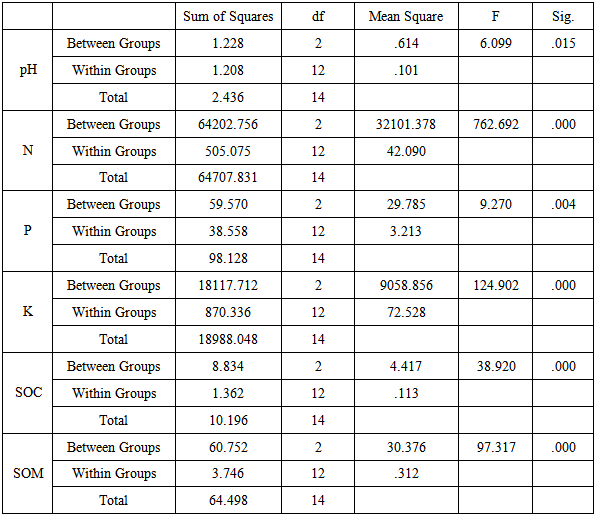-
Paper Information
- Paper Submission
-
Journal Information
- About This Journal
- Editorial Board
- Current Issue
- Archive
- Author Guidelines
- Contact Us
Resources and Environment
p-ISSN: 2163-2618 e-ISSN: 2163-2634
2014; 4(4): 181-189
doi:10.5923/j.re.20140404.01
Soil Nutrients and Fertility in Three Traditional Land Use Systems of Khonoma, Nagaland, India
Petevino Chase, O. P. Singh
Department of Environmental Studies, North Eastern Hill University, Shillong-793022, Meghalaya, India
Correspondence to: Petevino Chase, Department of Environmental Studies, North Eastern Hill University, Shillong-793022, Meghalaya, India.
| Email: |  |
Copyright © 2014 Scientific & Academic Publishing. All Rights Reserved.
Status of soil nutrients and fertility was studied in three traditional land use systems viz Natural Forest (NF); Alder based Jhum Fallow (JF) and Wet Terrace Paddy cultivation (PF) in Khonoma, Nagaland located in North- East India. Soil samples were collected from the three sites and soil fertility indicators such as pH, mineralizable Nitrogen (N), available Phosphorus (P), available Potassium (K), Soil Organic Carbon (SOC) and Soil Organic Matter (SOM) were analyzed using standard procedures. The soil of Natural Forest was found to be most fertile based on the calculated Nutrient Index followed by Alder based Jhum Fallow and Paddy Fields. The analysis of variance (ANOVA) showed significant (P< 0.05) differences among the three land use types with regard to the soil nutrients studied. These results showed that land use types have significant effect on soil nutrients and thus its fertility. Continuous agricultural activities deplete soil fertility, but by maintaining a period of fallow this decrease in soil fertility is reclaimed. The rate of reclamation from a nutrient deficient condition to nutrient rich condition is found to be enhanced in the study site by growing and maintaining Alnus nepalensis D Don, more popularly known as the Alder tree. This is evident from the present study of soil nutrients from 2-5 years old jhum fallows showing soil properties ranging between soils of paddy fields and Natural Forest. The study thus establishes that land use should be chosen with care to preserve the quality of the soil.
Keywords: Jhum fallow, Paddy field, Soil nutrients and fertility, Khonoma
Cite this paper: Petevino Chase, O. P. Singh, Soil Nutrients and Fertility in Three Traditional Land Use Systems of Khonoma, Nagaland, India, Resources and Environment, Vol. 4 No. 4, 2014, pp. 181-189. doi: 10.5923/j.re.20140404.01.
Article Outline
1. Introduction
- Forest ecosystems are important both ecologically and economically, and forest soil is the most fundamental terrestrial asset and natural resource [1]. However, non-forest activities are expanding rapidly worldwide at the expense of natural forests and at a pace which is much faster in environmentally fragile mountainous areas. Globally, agricultural expansion and infrastructural development contributes 37% of forest degradation, responsible for one third of tropical deforestation [7]. Land use in tropical areas cause significant modifications in soil properties in which agriculture have a major contribution [14] and especially cultivation of deforested land, may rapidly diminish soil quality [2]. These changes in land use is often localized and site specific, however their impacts collectively lead to changes in the larger global scale resulting in desertification, biodiversity loss, global warming, etc. Apart from land use, soil degradation also depends on soil types, topography and climatic factors. Tropical soils around the world are widely known to be declining in fertility. Soil is a non renewable resource and the need to protect, maintain or improve its ability to perform a myriad array of functions has been widely acknowledged. Thus, if used inappropriately it may deteriorate over a short period of time, with very little prospect for regeneration [24].To circumvent the difficulties of the hilly terrain, in North-East India, the local communities have developed unique indigenous farming systems based on local resources, which facilitate conservation as well as effective and efficient use of natural resources [27]. Three traditionally practiced agricultural systems forms the major land use in the tropical forest of Khonoma in Nagaland viz., Natural Forest, Alder based Jhum (shifting cultivation intercropped with Alnus nepalensis D. Don) and Wet Terrace Paddy cultivation. Alnus nepalensis D. Don is more commonly known as Alder trees. Hereafter, Alder based Jhum Fallow and Wet Terrace Paddy Fields will be referred to as Jhum Fallow (JF) and Paddy Field (PF) for convenience. The repeated use of cultivable land with short jhum cycle is feared to convert the Jhum Fields into wastelands. The region is bestowed with rich natural resources of soil, water, and climate [27] but high rainfall and mismanagement of rainwater has resulted in extreme soil erosion through runoff in the hills [26]. Studies on impact of jhum on soil are thus warranted to determine how availability of soil nutrients and soil fertility can be maintained and the land use systems improved. The Paddy Fields of Khonoma are intensively cultivated throughout the year, with a single crop of rice and a variety of vegetable crops are grown in succession after the harvesting of rice.North-East India is becoming increasingly deforested and its crop productivity is declining primarily due to shortening of jhum cycle [21]. Natural as well as anthropogenic activities have rendered natural resources viz soil, water, and forests, vulnerable to such an extent that river flow during the monsoon causes landslides and erosion, and during dry season, the problem of water shortage ensues [27].The effects of cropping systems and management practices on soil properties provide essential information for assessing environmental impact [10]. Analyzing the soil nutrient status to overcome the problems of ecological imbalance for sustainable crop production is one such method.In Khonoma, with increasing population, demand for food and fuel increased and land availability for agriculture has reduced. As a result, both these forms of traditional cultivation are getting modified and are being overused. In this study, the effects of land use systems are evaluated on the selected indicators of soil fertility to evaluate the changes in response to two different traditional agricultural land uses, taking forest as the control.
2. Study Area
- The study was conducted at Khonoma (Longitude E94°2′0″ Latitude N25°39′0) located about 20 km west of Kohima, the capital town of Nagaland, India. With its location at the foothill of the Barial range, Khonoma is a part of the Eastern Himalaya and Indo-Burma Biodiversity Hotspot [5]. The study area covers an area of about 123Km2 with elevation ranging from 1200 m to 2868 masl. The population of the village is 2,500 comprising of 500 households. The study area receives an annual rainfall of 2000 to 2500 mm from May to September, with a warm climate followed by dry and cold winter season from October to March. Atmospheric temperatures vary from 15℃ to 30℃ in summer and less than 5℃ to 25℃ in winter. Major soil types found in Khonoma are inceptisols which are soils in the beginning stages of formation and ullisols, base poor mineral soils developed under high rainfall and forest vegetation [15].Prior to any form of cultivation operating in Khonoma, a rich forest resource abounds in the area. A large part of these rich forests is still being preserved (Figure 2A). Agriculture is the main occupation of the Khonoma people and, Natural Forests, Alder based Jhum cultivation and Wet Terrace Paddy cultivation together represents the predominant traditional land use systems [5]. These systems of cultivation are best suited for the region under the prevailing climatic condition and topography. Alder based jhum among the Angamis is well developed in Khonoma village [11]. All kinds of essential crops like rice, maize, millet, soyabeans, potato, etc., are planted in mixture. The lands are abandoned after 2 years of cultivation for natural build up of soil fertility and regeneration of vegetation for 3-5 years (Figure 2B). With the capability of fixing Nitrogen and being fast- growing, the native tree Alnus nepalensis D. Don., intercropped in jhum fields in Khonoma requires less rejuvenation period. Wet Terraced Paddy cultivation is practiced throughout the hilly terrain, both at low and high elevations (Figure 2C). This form of cultivation system is a sedentary land use system based on the cultivation of paddy or rice (Oryza sativa) on soil flooded naturally or artificially induced. Some people continued the old tradition of planting only rice while others planted upto a dozen crops in addition to rice [4]. Paddy fields continue to produce good crops by use of Farm Yard Manure (FYM) and nutrient wash-out from the hill slopes and people do not make use of fertilizers. This land use system is cultivated year after year, unlike the jhum system that undergoes cropping once or twice in a few years of fallow interval depending upon the jhum cycle.
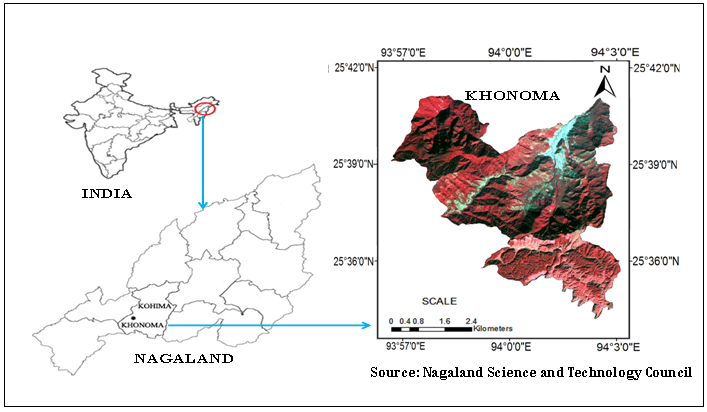 | Figure 1. Location map of Khonoma Village, Nagaland |
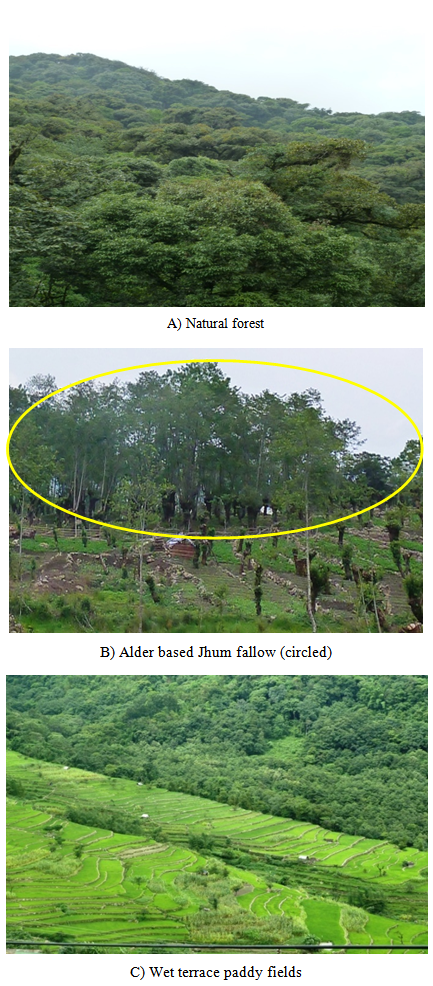 | Figure 2. Photographs showing a view of major land use system in Khonoma, Nagaland. A) Natural Forest; B) Alder based Jhum Fallow [encircled in yellow] and C) Wet terrace Paddy Fields |
3. Methodology
- Soil samples from three different land uses – Natural Forest, Jhum Fallow and Paddy Field were collected from the study area. Five replicates of the samples were collected at a depth of 0-20 cm at each site. These samples were then analyzed at the Soil Survey Laboratory, Directorate of Soil and Water Conservation, Kohima, Nagaland. The soil quality parameters such as pH (pH meter), mineralizable N (Kjeldahl method), available P (spectrophotometer), available K (flame photometer), SOM and SOC (Walkley-Black method) were analysed. Based on the soil test values for different nutrients, soils were classified into three categories viz low, medium and high nutrient status (Table 1). Using these fertility classes as proposed by [20], Nutrient Index was calculated using the following equation (1).
 | (1) |
|
4. Results and Discussions
- Soil parameters such as pH, N, P, K, SOC and SOC were studied in three land use systems viz Natural Forest, Jhum Fallow and Paddy Field. Results show that, all the measured soil parameters varied under the influence of the three land use systems (Table 3).
4.1. Statistical Descriptions
- The descriptive statistics (Table 2) of the soil nutrients studied suggested that they were all normally distributed with the values of the skewness of the various variables analysed lying within the range of -1 to +1. Skewness values of soil properties in the Paddy Field showed low deviation from normal distribution.
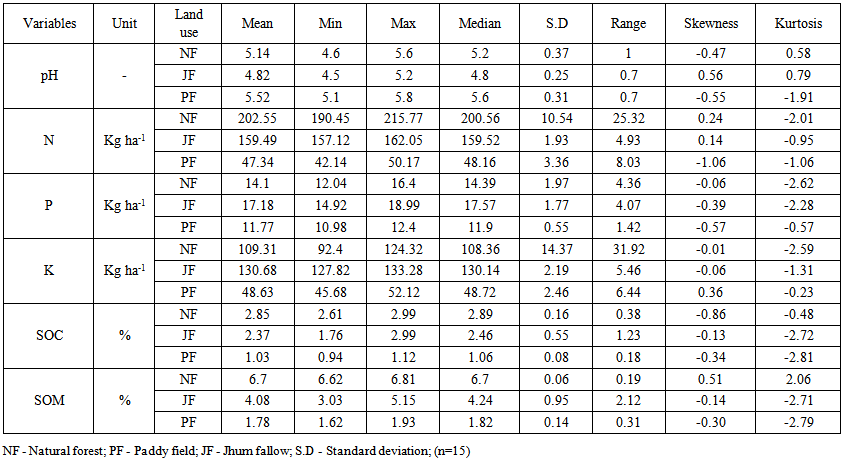 | Table 2. Summary of the Statistics for Selected Soil Nutrients in Different Land Uses in Khonoma |
4.2. Soil Nutrients in the Three Land Use Systems
- The soils of the three study sites are acidic with a mean pH of 5.16 in water since a pH value of 6.5 and less is considered acidic. The acidic soil reaction can be attributed to decomposition of SOM which releases organic acids leading to leaching of bases from the exchange complex under the prevailing high rainfall and hilly topography. Statistically significant difference (0.015 at p<0.05) on soil pH due to land use was found in the three sites (Table 3). The pH of the different land use follows the order Jhum Fallow > Natural Forest > Paddy Field. The pH of the soil at the study sites ranged from 4.6 to 5.6; 4.5 to 5.2 and 5.1 to 5.8 in Natural Forest, Jhum Fallow and Paddy Field respectively. The soils of the region are highly acidic and forest production on acid soils that are poor in basic cations is limited by mineral deficiencies [27]. The pH range of most productive agricultural soils is between 5.5 and 7.5 [30]. The pH of Paddy Fields in the study is found to be within this range and thus accounts for continued production of good crops with the use of Farm Yard Manure (FYM) and nutrient wash-out from the hill slopes without the use of fertilizers.
|
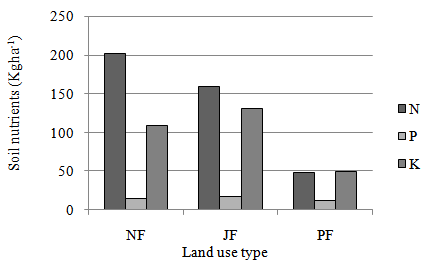 | Figure 4. Variation in NPK in soils of Natural Forest (NF), Jhum Fallow (JF) and Paddy Field (PF) |
4.3. Nutrient Index of Soils in Different Land Uses
- The nutrient index values of selected soil nutrients viz N, P and K of the three land use were calculated based on the equation (1). These nutrient index values were then characterized as Nutrient Index category I, II and III (Table 4).
|
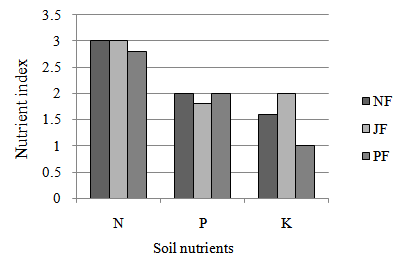 | Figure 5. Soil nutrient index based on NPK levels for Natural Forest (NF), Jhum Fallow (JF) and Paddy Field (PF) |
4.4. Soil Fertility in Three Land Use Systems
- Natural Forest was found to be richest in N, SOC and SOM while Jhum Fallow had the highest amount of P and K. The poorest in soil nutrients was found in Paddy Fields for all the soil nutrients analysed, where agricultural operation persists throughout the year without any fallow period and are cultivated devoid of any trees.Higher amounts of SOC, SOM and N were found in Natural Forest soils in agreement with a study of soils in Nagaland [28]. There was less variation between Natural Forest and Jhum Fallow on the amount of these soil nutrients. The higher availability of soil nutrients and thus, soil fertility status in Natural Forest could be due to the fact that the forest floor is herbaceous and abundant in leaf litter that covers the soil surface and does not withhold plant nutrients for a long period in the standing biomass which may otherwise lead to a extended period of nutrient cycling. Also SOM in the forested land was higher than in the other land uses, since the soil in the Natural Forest was not tilled or exposed to erosion [2]. This can also account for the higher SOM value in Jhum Fallow than in Paddy Field since tillage and erosion is comparatively lesser in Jhum system. Forest soils are more sensitive to acidification by strong mineral acids. Soil fertility thus depends on the SOM supplied by the natural vegetation and the nutrient cycling. Comparatively lower soil fertility status was reported in regenerating Jhum Fallow than Natural Forest. This is due to higher soil acidity conditions in soils of Jhum Fallow. The higher pH and the amount of P and K in the Jhum Fallow can be attributed to the fact that, during the slash and burn operation in the Jhum fields, the ash deposited by the burning of biomass practice releases K and P, causing higher pH and available P. The higher amount of nutrients responsible for soil fertility in Jhum Fallows as compared to Paddy Fields can be because of the Alder trees intercropped in all the Jhum fields in Khonoma. In the absence of fast nutrient cycling trees such as the Alder tree, 10 years of fallow period is necessary for overall soil fertility improvement from a net transfer of nutrients back to the soil [19]. N fixing Alder trees contribute substantially to overall soil fertility on farmlands since many such trees are fast growing and produce high quality, high protein livestock fodder and green manure. This leads many tropic and sub tropic highlands to intensively develop and support large human populations where indigenous actinorhizal N-fixing trees are widely employed in agroforestry systems [31]. Besides fixing atmospheric N, the litter of the trees add to the soil P, K, Ca, and other nutrients [25]. Normally a Jhum field is cultivated for two years within a nine-year cycle, but the Alder system allows two harvests in two out of every four to five years [17]. In Khonoma Alder based Jhum fields, fallow period as short as 2 years are sufficient for cultivation [4]. The availability of SOC and other major soil nutrients such as N, P and K increase in post burning fallow periods from 3-4 years onward and soils exhibited consistent increase in fertility built up [6]. In addition, Jhum Fallows might have especially taken advantage of the residual effect of the wood ash from the slash-and-burn practice. The burning of forest residues practiced during land clearing is leading to considerable nutrient loss from the ecosystem. Approximately 50 kg N ha-1 was released in a 24-month period from litter fall in pure stands of Alder trees [22]. Total soil Nitrogen, available Phosphorus, exchangeable Potassium, exchangeable Calcium, and Organic Carbon have been shown to increase with age under stands of Alder trees [23].The lowest SOC, SOM and Nitrogen level of soil was recorded in Wet Terrace Paddy fields. This is primarily attributed to fast oxidation of SOM, washing away of nutrient rich top soil with runoff water, rapid decomposition, poor recycling back of crop residues, continuous and intensive cultivation of crops without replenishment of nutrients through chemical fertilizers. Burning of crop residue and mismanagement of Farm Yard Manure can further lower values of SOC and N in Paddy cultivation. Continuous cultivation of soils reduces SOM by facilitating interactions of physical, chemical and biological soil processes that increases its decomposition rate. The puddling process in rice cultivation for transplanting the rice seedlings which breaks the soil aggregates and subjects the entrapped SOM fractions to further loss ultimately lead to poor soil structure. In paddy fields, exposure of the soil surface to heavy rains brings about erosion; plowing destroys and leads to rapid decomposition and mineralization of SOM, and intense leaching of nutrients thereby reducing the contribution of organic and microbial processes to nutrient cycling. The conversion of Natural Forest to cultivated land is manifested the most in the on-site loss of SOM causing a reduction in nutrient stock, CEC, and structure stability [9].In general, the results of soil analysis revealed less availability of soil nutrients among the three different land uses. This can be attributed to the non use of chemical fertilizers in the study area. Only small scale Farm Yard Manures are used as soil additive for vegetable crops in Paddy Fields.
5. Conclusions
- The conversion of Natural Forests into agriculture had resulted in changes in the availability of soil nutrients compared to soils in its natural state and shows statistically significant decreases in the amount of nutrients responsible for soil fertility. According to the soil fertility tests based on the calculated nutrient index of N, P and K, the soils of Natural Forest shows soil fertility status from high to low category; high to medium category for Jhum Fallow and medium to low category for Paddy Fields. Long-term continuous cultivation in the Wet Terrace Paddy cultivation system in Khonoma village significantly (p<0.05) decreased the SOM content in the soils. While Alder based Jhum practised with an interval of 2 years of cropping followed by 3-4 years or even a minimum of 2 years fallow period resulted in accumulation of substantial soil nutrients and does not show statistically significant difference in soil fertility indicators as compared to that of Natural Forest. This indicated that planting of well-adapted, native and fast-growing trees such as Alder trees can gradually improve the soil quality and rehabilitate degraded lands. In areas where agriculture depends on rainfall, attention should be focussed on conservation of soils on the hilly slopes by preventing deforestation and establishing appropriate forest cover and improving the existing forests. The decline of soil fertility is a major concern in relation to food production and the sustainable management of land resources [9]. These results confirms studies conducted around the world on the effect of land use on soil fertility and validate the finding that while agriculture significantly decrease soil fertility, degradation can be reversed and soil nutrient loss reclaimed by maintaining a period of fallow leading to subsequent regeneration of forest. The soils from Alder based Jhum Fallows in the present study showed soil properties similar to that of the Natural Forest. Sustained forest productivity requires the use of techniques which reduce nutrient export, increase nutrient accumulation in the biomass, increase efficiency of nutrient absorption and utilization and conservation of water in the system [27]. A balanced tree-crop combination is ideal for both production and maintenance of soil health [14].Thus we can conclude that, in the absence of proper management, the conversion of Natural Forest to cultivation leads to decrease in soil nutrients and thus, its fertility.
ACKNOWLEDGEMENTS
- The first author is grateful to the University Grants Commission for the financial support in the form of UGC NET SRF. We thank the Khonoma village leadership for granting the permission to conduct the study and sincere gratitude is due to the Department of Soil and Water Conservation, Kohima Nagaland for the laboratory facility and expert guidance in analysis of soil samples.
References
| [1] | Agoumé, V. and Birang, A.M., 2009, Impact of Land-Use Systems on Some Physical and Chemical Soil Properties of an Oxisol in the Humid Forest Zone of Southern Cameroon, Tropicultura, 27(1), 15-20. |
| [2] | Ayoubi, S., Khormali, F., Sahrawat, K.L., Rodrigues de Lima, A.C., 2011, Assessing Impacts of Land Use Change on Soil Quality Indicators in a Loessial Soil in Golestan Province, Iran, J. Agr. Sci. Tech., 13,727-742. |
| [3] | Brown, J.R., Crocker, D.K., Garrett, J.D., Hanson, R.G., Lory, J.A., Nathan, M.V., Scharf, P.C., and Wheaton, H.N., 2004, Soil Test Interpretations and Recommendations Handbook, University of Missouri – College of Agriculture, Division of Plant Sciences, 35pp. |
| [4] | Cairns, M., and Brookfield, H., 2011, Composite Farming Systems in an Era of Change: Nagaland, Northeast India, Asia Pacific Viewpoint, 52(1), 56–84. |
| [5] | Chase, P., and Singh, O.P., 2012, People’s Initiative for Conservation of Forests and Natural Resources: A Success Story of Khonoma Village Forest, Nagaland, Nebio, 3(3), 61-67. |
| [6] | Devi, N.L., and Choudhury, B.U., 2013, Soil Fertility Status in Relation to Fallow Cycles and Landuse Practices in Shifting Cultivated Areas of Chandel District Manipur, India, IOSR Journal of Agriculture and Veterinary Science, 4(4),1-9. |
| [7] | Geist, H.J., and Lambin, E.F., 2002, Proximate Causes and Underlying Driving Forces of Tropical Deforestation, Bioscience, 52, 143-150. |
| [8] | Gol, C., 2009, The Effects of Land Use Change on Soil Properties and Organic Carbon at Dagdami River Catchment in Turkey, Journal of Environmental Biology, 30(5), 825-830. |
| [9] | Hartemink, A. E., Veldkamp, T., and Bal, Z., 2008, Land Cover Change and Soil Fertility Decline in Tropical Regions, Turk. J. Agric. For., 32, 195-213. |
| [10] | Ishaq, M.I., and Lal, R., 2002, Tillage Effects on Soil Properties at Different Levels of Fertilizer Application in Punjab, Pakistan, Soil Till. Res., 68, 93-99. |
| [11] | Khikhi, C., and Khikhi, K., 2009, The Role of Women in Natural Resource Management: A Thematic Report, Published by Department of Planning and Coordination Government of Nagaland. GOI-UNDP PROJECT. Strengthening of state plans for human development, pp. 9. |
| [12] | Maithani, K., Arunachalam, A., Tripathi, R.S., and Pandey, H.N., 1998, Nitrogen Mineralization as Influenced by Climate, Soil and Vegetation in a Subtropical Humid Forest in Northeast India, Forest Ecology and Management, 109, 91-101. |
| [13] | McGrath, D.A., Smith, C.K., Gholz, H.L., and F., de Assis Oliveira, 2001, Effects of Land-Use Change on Soil Nutrient Dynamics in AmazoˆNia, Ecosystems, 4, 625–645. |
| [14] | Pal, S., Panwar, P., and Bhardwaj, D.R., 2013, Soil Quality Under Forest Compared to Other Land Uses in Acid Soil of North Western Himalaya, India, Ann. For. Res., 56(1), 187-198. |
| [15] | Pareta, K., 2013, Assessment of Carbon Stocks in Shifting Cultivation Lands: A Case Study of Nagaland State of India, Esri International user conference, pp. 2-20. |
| [16] | Pathak, H., 2010, Trend of Fertility Status of Indian Soils, Current Advances in Agricultural Sciences, 2(1), 10-12. |
| [17] | Pulamte, L., 2008, Understanding Innovations in Traditional Agriculture of Northeast India-the Case for Sustainable Development, VI Globelics Conference, September 22-24, Mexico City, pp. 1-14.www.fes.uwaterloo.ca/u/marahman/PhD_Comprehensive.html. |
| [18] | Purkayastha, A., Varghese, S., and Purkayastha, A., 2011, Nutrient Indices of Barak Valley Tea Soils with Reference to Organic Matter and Soil Available Potash Status, Two and a Bud, 58,118-119. |
| [19] | Ramakrishnan, P.S., 1994, The Jhum Agroecosystem in Northeastern India: A Case Study of the Biological Management of Soils in a Shifting Agricultural System in, Woomer, P.L., and Swift, M.J., (Eds.) The Biological Management of Tropical Soil Fertility, TBSF, a Wiley-Sayce Publication, pp. 189-208. |
| [20] | Ramamoorthy, B., and Bajaj, J.C., 1969, Soil Fertility Map of India, Fertil. News, 14(8), 25. |
| [21] | Rathore, S.S., Karunakuran, A., and Prakash, B., 2010, Alder Based Farming System a Traditional Farming Practices in Nagaland for Amelioration of Jhum Land, Indian Journal of Traditional Knowledge, 9(4), 677-680. |
| [22] | Sharma, E., and Ambasht, R.S., 1987, Litterfall, Decomposition and Nutrient Release in an Age Sequence of Alnus nepalensis Plantation Stands in the Eastern Himalaya, Journal of Ecology, 75, 997-1010. |
| [23] | Sharma, E., Ambasht, R. S., and Singh, M. P., 1985, Chemical Soil Properties Under Five Age Series of Alnus nepalensis Plantations in the Eastern Himalayas, Plant and Soil, 84, 105-113. |
| [24] | Sharma, K.L., Mandal, B., and Venkateswarlu, B., 2012, Soil Quality and Productivity Improvement Under Rainfed Conditions – Indian Perspectives, chapter 8, in Resource Management for Sustainable Agriculture, InTech, pp. 203-237. http://creativecommons.org/licenses/by/3.0. |
| [25] | Sharma, U.C. and Singh, K.A., 1994, Agriculture with Alder – A Potential Indigenous Farming System of Nagaland. In: Proceedings of the National Seminar on Developments in Soil Science, 28 Nov to 1 Dec, ICAR, New Delhi, India, pp. 570–571. |
| [26] | Sharma, U.C., and Sharma, V., 2010, Impact of Land Use and Hydrology on the Soil Characteristics and Productivity in Highland Agriculture with Watershed Approach, 19th World Congress of Soil Science, Soil Solutions for a Changing World 1 – 6 August 2010, Brisbane, Australia, pp. 44-47. |
| [27] | Singh, A.K., 2010, Probable Agricultural Biodiversity Heritage Sites in India: VI. The Northeastern Hills of Nagaland, Manipur, Mizoram, and Tripura, Asian Agri-History 14(3), 217–243. |
| [28] | Singh, P.K., and Munth, H., 2013, Fertility Status of Soil under Forest and Cultivated Land Use System of Nagaland: A Comparative Study, Asian J. Soil Sci., 8(2), 470-475. |
| [29] | Templer, P.H., Groffman, P.M., Flecker, A.S., and Power, A.G., 2005, Land Use Change and Soil Nutrient Transformations in the Los Haitises Region of the Dominican Republic, Soil Biology & Biochemistry 37, 215–225. |
| [30] | Wubie, M.A., 2013, Impacts of Land Use System on Soil Properties and Fertility Status in the Mizewa Watershed of Lake Tana Basin, North Western Ethiopia, International Journal of Research in Commerce, Economics & Management, 3(9), 120-124. |
| [31] | Zomer, R., and Menke J., 1993, Site Index and Biomass Productivity Estimates for Himalayan Alder-Large Cardamom Plantations: A Model Agroforestry System of the Middle Hills of Eastern Nepal, Mountain Research and Development, 13(3), 235-255. |
 Abstract
Abstract Reference
Reference Full-Text PDF
Full-Text PDF Full-text HTML
Full-text HTML
